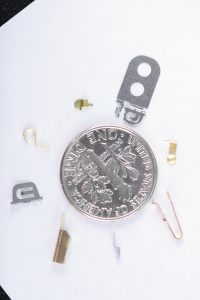 Metal part stamping is a unique art in the complex world of manufacturing. This is especially true when it comes small or very small parts. Precision is not only a requirement, but a necessity when it comes to crafting tiny components. We’ll explore why precision is so important and how to achieve it in the small and very tiny metal parts stamping.
Metal part stamping is a unique art in the complex world of manufacturing. This is especially true when it comes small or very small parts. Precision is not only a requirement, but a necessity when it comes to crafting tiny components. We’ll explore why precision is so important and how to achieve it in the small and very tiny metal parts stamping.
The stamping of small and very tiny metal parts is essential for high precision and quality when manufacturing tiny components. This is important in industries such as electronics, aerospace and medical devices.
The following sections will explore the materials that are best suited to this process, the conditions where it is the preferred manufacturing method, its worldwide demand, and the measures taken to ensure perfection in each stamp.
Why is precision more important in small and very tiny metal parts stamping?
Precision is a word that has a lot of resonance in the complex and vast world of manufacturing. This is especially true when it comes to small and very tiny metal parts stamping. In crafting these tiny components, the quest for precision is more than just meeting a standard. It’s about achieving excellence, which plays a crucial role in the functionality, safety and ultimate performance of the product. We will examine the importance of small and very tiny metal parts stamping.
Precision is important for safety and functionality
It is important to note that the functionality of a machine or device can be directly related to how precisely its parts have been manufactured, especially when they are very small metal components. A minor error in the stamping can cause a cascade malfunction that renders the product unusable or unsafe. In the medical device sector, for example, a lack in precision can lead to fatal mistakes. Small metal parts are often used in life-saving devices. In the aerospace and automotive industries, there is virtually no margin for error, so precision becomes a necessity.
Impact on the final product’s performance
A product’s quality is determined by its parts. Precision in the stamping of small and very tiny metal parts is directly related to a product’s performance, reliability and durability. To ensure smooth operation, each small part must be able to interact with other parts seamlessly. A discrepancy between the dimensions or structural integrity of a product could lead to performance problems, resulting in a shorter life expectancy or, worst case scenarios, catastrophic failures. Precision in stamping metal parts is therefore essential to maintain the high performance standards demanded by modern consumers and industries.
The Challenges of High Precision
The small size of the parts makes it difficult to achieve precision in stamping. Modern technologies and innovative techniques made it possible for these challenges to be overcome. The use of high-speed stamping techniques, progressive dies, and fineblanking has been crucial in enhancing precision. Incorporating sophisticated tools such as computer-aided designing (CAD) or computer-aided manufacture (CAM) into the metal stamping process has been a major boost to the industry. It allows for the creation of precise and detailed components even when the design is complex.
The world of small and extremely small metal parts stamping is testament to the human ingenuity, and the pursuit of perfection. Precision is the story of safety, performance enhancement, and overcoming obstacles through modern technology and innovative techniques. The quest for precision is increasing as the demand for miniature components increases.
What types of materials are best suited for stamping small and very small metal parts?
The selection of the right material for metal stamping is crucial, especially when it comes to small components. The best choice will enhance the stamping process, ensure the component’s performance and operational life, and comply with the standards of various sectors. Exploring the properties of different metals for small parts stamping will help you determine which ones are best suited for this precise work.
Comparison of Metals and Their Suitability
Different metals can have different properties which make them suitable or unsuitable for small parts stamping.
- Steel : Stainless steel is a good example of a material that’s often used for small parts stamping because it’s robust, durable, and resistant to corrosion. Its ability in harsh environments makes it popular for a variety of industrial uses.
- Aluminum: Aluminum, due to its light weight and corrosion resistance, is highly valued for metal stamping small parts. The good thermal and electric conductivity makes it a great choice for electronic and automotive components.
- Copper Known for having excellent electrical conductivity and is used frequently in electrical components. Its malleability is a great candidate for small parts stamping.
- Brass: Composed of copper and zinc and renowned for it’s machinability, anti-corrosive qualities, making it a perfect material for stamping.
- Alloys of Nickel: Nickel alloys are renowned for their high resistance to corrosion, and for being able to withstand elevated temperatures. They are ideal for demanding applications.
Each metal has distinct advantages, which allows for a selection that is tailored to the specific needs of a project.
The properties of a material that make it ideal for stamping small parts
Some properties of a material make it more suitable for the stamping process. This is especially true when working with small or very small parts.
- Malleability: A malleable material is easier to stamp and shape without breaking or cracking.
- Strength: Materials that are strong can withstand the pressures and rigors associated with the stamping process, as well as the operational requirements of the final application.
- Conductivity: Metals with good thermal and electrical conductivity are preferred for electronic applications.
- Corrosion Resistant: Materials resistant to corrosion will ensure that stamped parts last longer, and reduce maintenance costs.
- Machinability: The more easily a material can be machined, the better it is suited for precision stamping.
- Cost-effectiveness : Metals readily available and cost effective are often preferred when small parts are being stamped, especially for high-volume projects.
It is important to consider the application, the stamping method, and your budget when choosing a material. Understanding the properties and benefits of different metals will help manufacturers make informed decisions to ensure the success of small and very tiny metal parts stamping projects.





